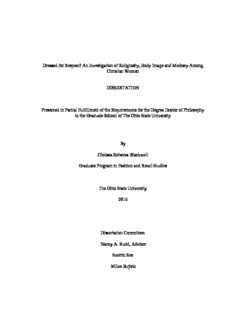
Dressed for Respect? An Investigation of Religiosity, Body Image and Modesty Among Christian ... PDF
Preview Dressed for Respect? An Investigation of Religiosity, Body Image and Modesty Among Christian ...
Dressed for Respect? An Investigation of Religiosity, Body Image and Modesty Among Christian Women DISSERTATION Presented in Partial Fulfillment of the Requirements for the Degree Doctor of Philosophy in the Graduate School of The Ohio State University By Chelsea Rebecca Blackwell Graduate Program in Fashion and Retail Studies The Ohio State University 2016 Dissertation Committee: Nancy A. Rudd, Advisor Soobin Seo Milos Bujisic Copyrighted by Chelsea Blackwell 2016 Abstract In the western world, questions pertaining to modesty such as how much skin can one reveal or not reveal are being asked since it is seen heavily in the media and celebrity culture. As a function of dress, modesty is concerned with the concealing of oneself and the body (Flugel, 1930). This function has an impact on body image especially since most women experience normative discontent or a regular dissatisfaction with their appearance (Rodin, Silberstein, & Striegel-Moore, 1984). Researchers have actively been looking for ways to relieve poor body image, which include ways religious identity improves body satisfaction (Boyatzis, Kline, & Backof, 2007; Mahoney et al., 2005). The purpose of this study was to determine the impact of Christian identity on modesty and how modesty in many forms influenced body image. Using the social identity theory approach, Christian identity was conceptualized as a group identity, which had norms including modesty and beliefs about the body (Hogg & Reid, 2006; Tajfel & Turner, 1986; Terry & Hogg, 1996). These norms influenced definitions of modesty, which has been conceptualized in multiple ways including concealment, respect, purity, and humility (Andrews, 2011; Hahner & Varda, 2012). Body image and appearance has linkages to self-objectification(Fallon, 1990; McKinley & Hyde, 1996a). Through connecting these concepts of Christian identity, modesty, and body image, a model was developed. ii An online survey (n=428) with snowball sampling of Christian adult women was conducted to measure these concepts. It was hypothesized that Christian identity through religious orientation would positively impact modesty, which would then positively impact body image. Confirmatory factor analysis and structural equation modeling was used to determine the validity and significant pathways of the model. It was found that the social aspect of extrinsic religious orientation impacted several types of modesty including contextual and esteem modesty. Religious beliefs about the body and personal values such as prayer positively influenced religious or respect driven modesty. These types of modesty had an effect on body image such as appearance evaluation and body surveillance. These findings suggested when rooted in Christian identity, modesty functioned as a filter and armor. When the social identity is highlighted, modesty filters out what is important when monitoring the body and evaluating appearance. When personal values and beliefs about the body are emphasized, modesty is armor or a defense against negative body messages. Recommendations for future research include investigating modesty and body shame as well as studying the impact of modesty on social media presentation. iii Dedication To all the women that participated in this study. May God make you whole in mind and body. I pray you experience the peace of Christ and encounter the real and active God in your lives. iv Acknowledgments I would like to thank my professors at Ohio State University for their guidance and knowledge that have been so helpful in my doctoral degree journey. First, my advisor, Dr. Nancy A. Rudd, I appreciate her unconditional support of me as her student and mentee. She was instrumental in this dissertation process from choosing the topic to discussing the implications of this study. I am grateful for her wisdom and passion for teaching. To Dr. Soobin Seo and Dr. Milos Bujisic, I value the feedback, knowledge, and time you gave to help me complete this project. To my family- my mother, father, and sister, I am indebted to you for being my cheerleaders. Thanks for the encouragement and feedback you gave throughout this entire four-year process. I could not have done this without your support! To my savior Jesus Christ, this study would not have been possible without your presence moving in my life. I pray that this research reaches many women and that this is just the beginning of a wonderful adventure. v Vita 2010………………………………………….B.B.A Management, B. F. C. S. Fashion Merchandising, University of Georgia 2012………………………………………….M.S. Merchandising, Apparel, and Textiles, University of Kentucky 2012-present…………………………………Graduate Teaching Associate, Department of Human Sciences, The Ohio State University Fields of Study Major field: Fashion and Retail Studies vi Table Of Contents Page Abstract……………………………………………………………………………………ii Dedication………………………………………………………………………………...iv Acknowledgments…………………………………………………………………………v Vita………………………………………………………………………………………..vi Table of Contents………………………………………………………………………...vii List of Tables…………………………………………………………………………….xii List of Figures…………………………………………………………………………...xiii Chapters: 1. Introduction……………………………………………………………………………..1 Problem Statement……………………………………………………...…………1 Purpose…………………………………………………………………………….3 Significance of Study…...…………………………………………………………4 Definition of Terms...……………………………………………………………...5 2. Literature Review……………………………………………………………………….7 Identity and Social Identity Theory….…………………………….……………...7 Religion as a Social Identity…....…………………………………………............8 Religious Orientation…...……………………………………………..…10 Religious Orientation and Well-Being……..…………………………….12 vii Sanctification…………………………………………………………………….12 Modesty……………………………………………………………………..........14 Modesty and Views Toward Women……………………………………17 Body Image and the Body…………………………………………………..…....21 Views of the Body and Theology………………………..……………....22 Religion, Health, and Body Image.…...………………………….............24 Objectification and Self- Objectification…………….…………………………..28 Summary and Conceptual Model……………...…………………………………34 Summary of Hypotheses……………………...………………………………….37 3. Method…………………………………………………………………………….…..40 Sample………………………………………………………………………...….41 Instruments…………………………………………………………………….....40 New Indices of Religion…………………………………………………40 Manifestation of God in the Body……………………………………….40 Appearance Orientation………………………………………………….41 Appearance Evaluation…………………………………………………..41 Body Surveillance………………………………………………………..42 Your Views of Modesty...………………………………………………..42 Demographic Variables………………………………………………….43 Data Analysis……………………………………………………………….........43 4. Results…………………………………………………………………………………46 Preliminary Data Analysis……………………………………………………….46 Sample Characteristics…………………………………………………...46 viii Scale Descriptives………………………………………………………..50 Extrinsic Religious Orientation…………………………………..51 Intrinsic Religious Orientation…………………………………...51 Manifestation of God in the Body……………………………….51 Views of Modesty………………………………………………..52 Body Surveillance………………………………………………..52 Appearance Orientation………………………………………….52 Appearance Evaluation………………………………………..…53 Confirmatory Factor Analysis……………………………………………………54 Modification Indices……………………………………………………..57 Model Fit…………………………………………………………………………60 Hypotheses……………………………………………………………………….62 Hypothesis 1……………………………………………………………...62 Hypothesis 2……………………………………………………………...62 Hypothesis 3……………………………………………………………...63 Hypothesis 4……………………………………………………………...64 Hypothesis 5……………………………………………………………...65 Hypothesis 6……………………………………………………………...65 Hypothesis 7……………………………………………………………...68 Hypothesis 8……………………………………………………………...68 Hypothesis 9……………………………………………………………...69 Hypothesis 10…………………………………………………………….69 Hypothesis 11…………………………………………………………….70 ix
Description: